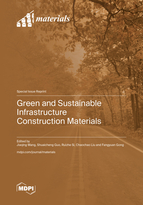Green and Sustainable Infrastructure Construction Materials
A special issue of Materials (ISSN 1996-1944). This special issue belongs to the section "Construction and Building Materials".
Deadline for manuscript submissions: closed (30 November 2023) | Viewed by 15965
Special Issue Editors
Interests: sustainable infrastructure materials; rubberized concrete; fiber-reinforced concrete; utilization of MSW; asphalt concrete materials; material macro and micro characterizations; FEM fracture analysis
Special Issues, Collections and Topics in MDPI journals
Interests: concrete; durability; fracture mechanics; non-destructive evaluation; freeze–thaw
Special Issues, Collections and Topics in MDPI journals
Interests: geopolymer; microstructure; drying shrinkage; mechanical properties; durability of cement-based composites
Special Issues, Collections and Topics in MDPI journals
Interests: materials and structure design of durable asphalt pavement; modified asphalt and mixtures; reclaimd asphalt pavement; cement-treated aggregates
Special Issues, Collections and Topics in MDPI journals
Interests: material and structure of road engineering; intelligent detection and repair of pavement disease; micro-structure evaluation and analysis of road materials; development and preparation of sustainable road materials
Special Issues, Collections and Topics in MDPI journals
Special Issue Information
Dear Colleagues,
It is our pleasure to invite you to submit a manuscript for this Special Issue, in the form of an original research article or review paper.
With the rapid development of infrastructure constructions, greener and more sustainable materials have been investigated and applied. Recently, infrastructure construction materials were discovered which are suitable for utilization in low-emission applications and environment protection. In addition, innovative sustainable techniques in the production and use of these materials have also attracted more attention.
This Special Issue will focus on the green and sustainable utilization of infrastructure materials. The main sub-topics include innovative techniques in the application of these materials in infrastructures (pavement, bridges, composite structures, etc.), effective methods for the recycling of these materials in constructions, and the multi-scale material characterization and modeling of composite materials containing these components.
Therefore, this Special Issue will provide an opportunity for peers in the related fields to publish recent findings with the advances in green and sustainable construction materials.
Potential topics include, but are not limited to, the following:
- Innovative techniques in green and sustainable construction materials.
- Using recycled materials to facilitate sustainability.
- Multi-scale evaluation of green and sustainable materials for infrastructure constructions.
- Investigations of composite materials and structures made of green and sustainable materials.
- Treatment methods of green and sustainable construction materials for better durability.
Dr. Jiaqing Wang
Dr. Shuaicheng Guo
Dr. Ruizhe Si
Dr. Chaochao Liu
Dr. Fangyuan Gong
Guest Editors
Manuscript Submission Information
Manuscripts should be submitted online at www.mdpi.com by registering and logging in to this website. Once you are registered, click here to go to the submission form. Manuscripts can be submitted until the deadline. All submissions that pass pre-check are peer-reviewed. Accepted papers will be published continuously in the journal (as soon as accepted) and will be listed together on the special issue website. Research articles, review articles as well as short communications are invited. For planned papers, a title and short abstract (about 100 words) can be sent to the Editorial Office for announcement on this website.
Submitted manuscripts should not have been published previously, nor be under consideration for publication elsewhere (except conference proceedings papers). All manuscripts are thoroughly refereed through a single-blind peer-review process. A guide for authors and other relevant information for submission of manuscripts is available on the Instructions for Authors page. Materials is an international peer-reviewed open access semimonthly journal published by MDPI.
Please visit the Instructions for Authors page before submitting a manuscript. The Article Processing Charge (APC) for publication in this open access journal is 2600 CHF (Swiss Francs). Submitted papers should be well formatted and use good English. Authors may use MDPI's English editing service prior to publication or during author revisions.
Keywords
- sustainable infrastructure materials
- rubberized concrete
- fiber-reinforced concrete
- asphalt and mixtures
- material and structure of road engineering








